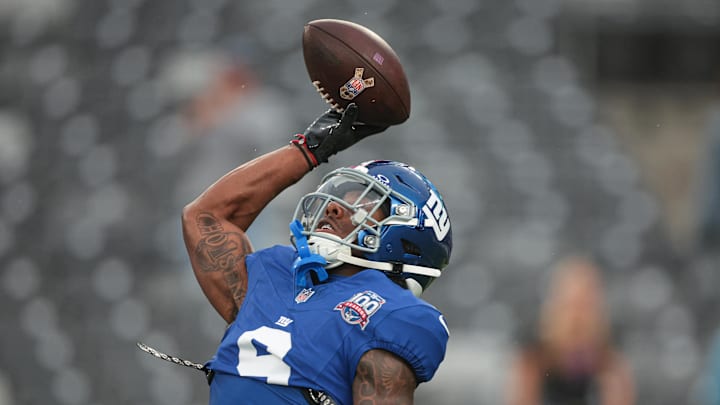Three Creative Ways Giants Can Get WR Malik Nabers More Involved in Passing Game

“Throw him the ball.”
That was New York Giants head coach Brian Daboll’s response when asked how they can get rookie wide receiver Malik Nabers more pass targets moving forward. For those who missed it, Nabers had a rather quiet NFL regular season debut in the Giants’ Week 1 28-6 debacle to the Minnesota Vikings.
In that game, he was targeted seven times, catching five for 66 yards and no touchdowns. He also had a dropped pass to start the game.
According to NFL NextGen Stats, Nabers had defenders giving him an average of 5.4 yards of cushion. He averaged 3.9 yards of separation but was only targeted an average of 6.6 air yards, meaning the team was hoping to get the ball to him on short and intermediate routes and let him do the rest.
Nabers, though, has shown both in college and in training camp that he is capable of more explosive playmaking, that is if the quarterback can accommodate. There are three ways the Giants' offensive brain trust can put the rookie in a position to make some of the more explosive plays his talent suggests he’s capable of making at this level.
Pre-snap Alignment
When Nabers broke out as a star and elite prospect for LSU in 2023, they moved him all around their offensive formation. Last season, Nabers aligned in the slot 53.6% of his snaps compared to 46% on the outside.
He was most effective in the slot because it provided him with a two-way go to defeat defensive backs in man coverage. LSU made it easy for Nabers to get matched up against slot corners and flat-footed safeties.
In Week 1 of his NFL debut, Nabers lined up on the outside 88% of his snaps. This limited his effectiveness and ability to get into the open field for yards after the catch. The Minnesota Vikings played two-man under/trail with the intent to double-team Nabers and limit explosive plays. Placing him in the slot can nullify bracket coverage and double-teams.
Pre-snap Motion
Putting Nabers in motion pre-snap as the play clock winds down forces the defense to adjust later than they prefer. It can force them to showcase their hand in terms of what coverage they are running.
Nabers should be utilized pre-snap as the coverage indicator to help give Jones answers before the snap. Daboll should experiment with different alignments in general for Nabers, adding some running back alignments in shotgun sets.
NFL defensive coordinators prefer to place their top cornerback on Nabers and potentially travel with him, so by placing him in the backfield with a late motion into the slot, the Giants can win the matchup and thwart the opposing defensive coordinator’s plan.
Quick-hitting Routes/Rubs
Getting Nabers involved in the passing game early is paramount to building rhythm and confidence between him and quarterback Daniel Jones. The quick passing game is similar to layups in basketball in that it helps to see passes completed and successful.
Dialing Nabers' numbers in the quick passing game begins to pull the secondary and coverage aggression downhill. Opening double moves and access to the deeper portions of the field.
In addition to creating more opportunities for Nabers to gain yards after the catch and break into the open field, rub or pick routes should be deployed to create chaos and free up Nabers from sticky man coverage defenders.
Using bunch/stacked sets will make it more difficult to get hands on Nabers off the ball, and multiple receivers will release into their routes from a bunched grouping.
Final Thoughts
Nabers is more than capable of winning his reps one-on-one, but as a hyped rookie receiver, he becomes a "spotlight" player for the defense who will make sure they know where he is at all times. Being more creative in deploying this young talent will make it more difficult for defenses to defend him and will give the Giants a competitive edge.
